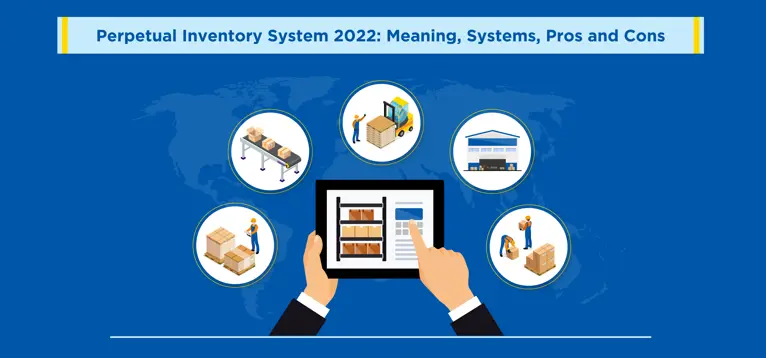Inventory is the spine of every business and can be a great asset for the company. However, 46% of SMBs still don’t keep a track of their inventory. If you fail to manage it appropriately it can soon turn into a liability that haunts you more than your scariest nightmare.
You need enough inventory on hand to meet client demand, but not so much that you're overspending on storage. So here’s where inventory management comes into the picture. When implemented correctly it can help you strike the perfect balance and be on top of your inventory.
Surprisingly, most firms are unsure whether they need an organized method to properly manage their inventory. Once they conclude that they do, they're stuck deciding whether to use a perpetual inventory system, a periodic inventory system, ABC analysis, Just in time, FIFO, LIFO, EOQ, and so on. If you are going through a similar conundrum this blog will help you understand one of the several methods, perpetual inventory management, in detail.
The perpetual inventory system is a dependable technique to retain real-time inventory track. Continue reading to find out what a perpetual inventory system is and how it functions.
What is Inventory Management?
Inventory, in simple terms, refers to the items that a company wants to sell to its customers for a profit. Management of these goods aka the inventory involves the tracking of goods from producers to warehouses and from these facilities to the point of sale.
Inventory management is necessary as it ensures that the appropriate products are in the right place at the right time. This warrants visibility of the inventory, which includes knowing when to order, how much to order, and where to store it.
Types of Inventory Management
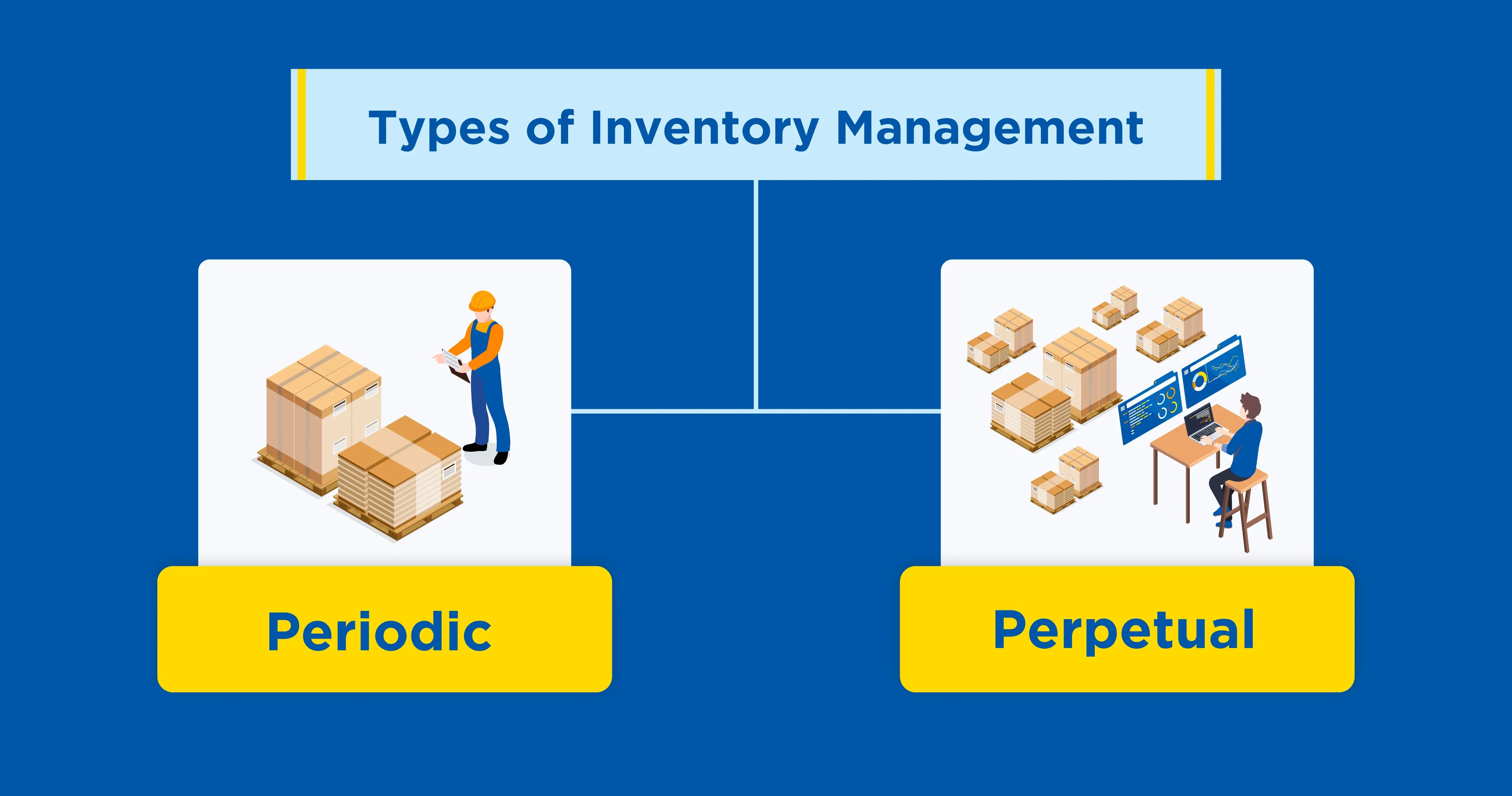
No matter the method of inventory management you choose, it's critical to have all of the facts and to use them as regularly as possible once implemented. Periodic and perpetual inventory management are two prevalent inventory management strategies. Choosing which one to utilise is critical to your company's success. The key distinction between the two systems is the frequency with which inventory data is updated.
Periodic
The periodic system is a process of inventory valuation for financial reporting purposes in which the inventory is physically counted at predetermined times. This accounting method calculates the Cost Of Goods Sold (COGS) by taking an inventory at the start of the specified period, adding new inventory purchases throughout the period, and subtracting ending inventory.
Companies utilise the periodic inventory system, also known as the noncontinuous system, to account for their items. A periodic inventory does not retain a constant track of items, purchases, sales, and their associated costs because it is based on a specific accounting period.
Perpetual
The perpetual inventory technique is a form of inventory accounting that keeps track of goods purchases and sales. All of this is accomplished using inventory management software. It gives you a real-time picture of inventory levels at any particular time.
The products are entered into a database as soon as they are purchased from the supplier. When a product is sold, it is removed from a database right away. The amount of product on hand will always be appropriately shown in the database.
Businesses don't have to worry about "taking inventory" when they employ perpetual inventory because it's done automatically and continuously. Purchases and returns are automatically recorded in the inventory count in the perpetual inventory system.
To track inventory in real-time, the perpetual inventory system uses barcode scanners, radio frequency identification (RFID) scanners, and inventory management software that is integrated with POSes, CRMs, MarketPlaces like Amazon FBA, purchase, order, and return management software.
Formulas
- Economic Order Quantity (EOQ)
The Economic Order Quantity (EOQ) model is used to assess how much inventory to purchase in order to meet demand while lowering inventory holding costs. Perpetual inventory accounting lets you to keep track of your inventory flow, allowing you to simply compute EOQ. The formula is:
Q = √2DS/H
Where
Q=EOQ units
D=Demand in units (typically on an annual basis)
S=Order cost (per purchase order)
H=Holding costs (per unit, per year)
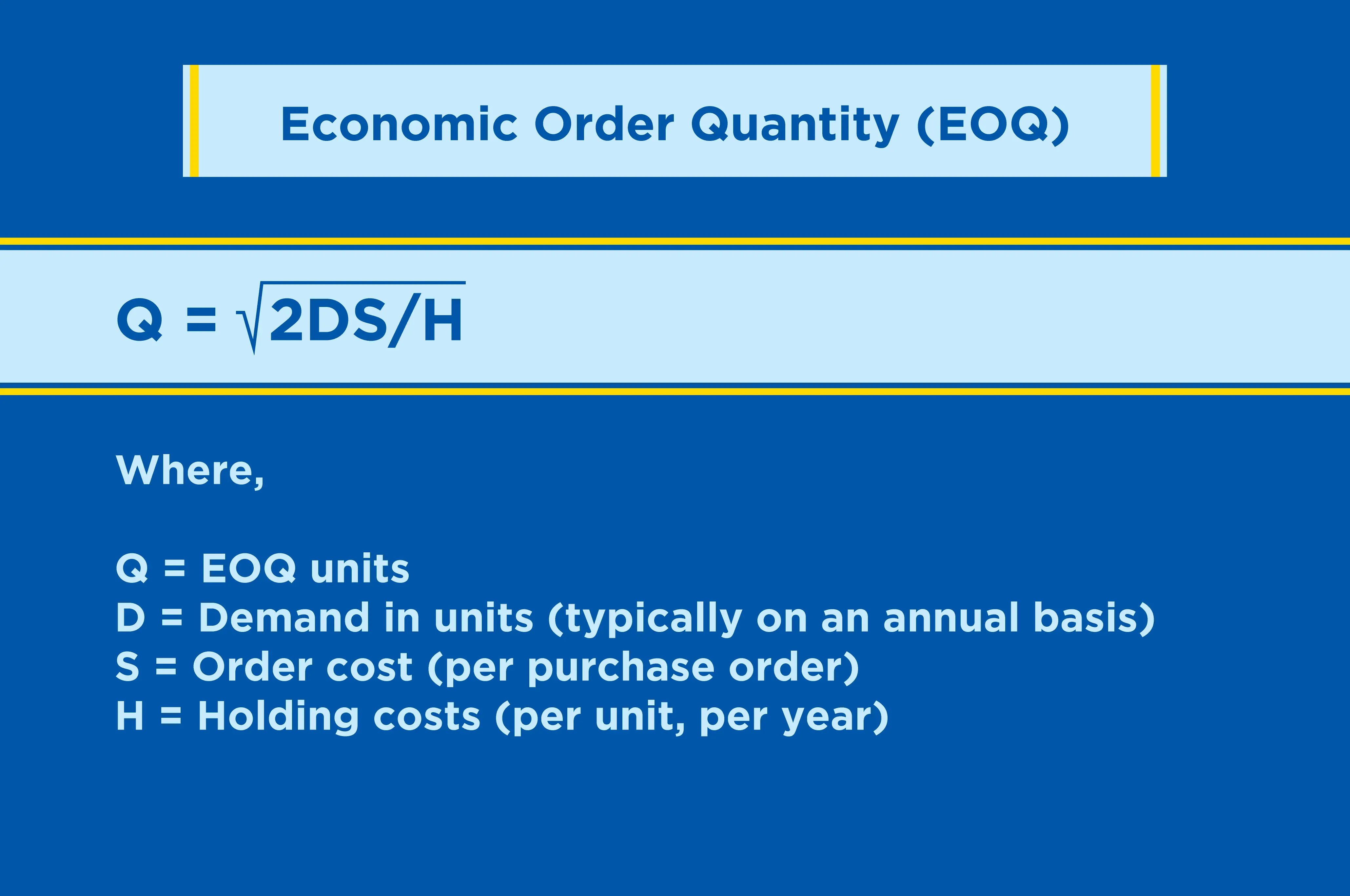
2. The Cost Of Goods Sold (COGS)
The COGS is likewise calculated perpetually in the perpetual inventory technique. The cost of sales, also known as the cost of goods sold, rises when the product is sold (COGS). It includes the money spent on goods production, as well as labour and material expenditures. The formula is:
COGS = BI + P – EI
Where,
BI = Beginning Inventory
P = purchase for the period
EI = Ending inventory
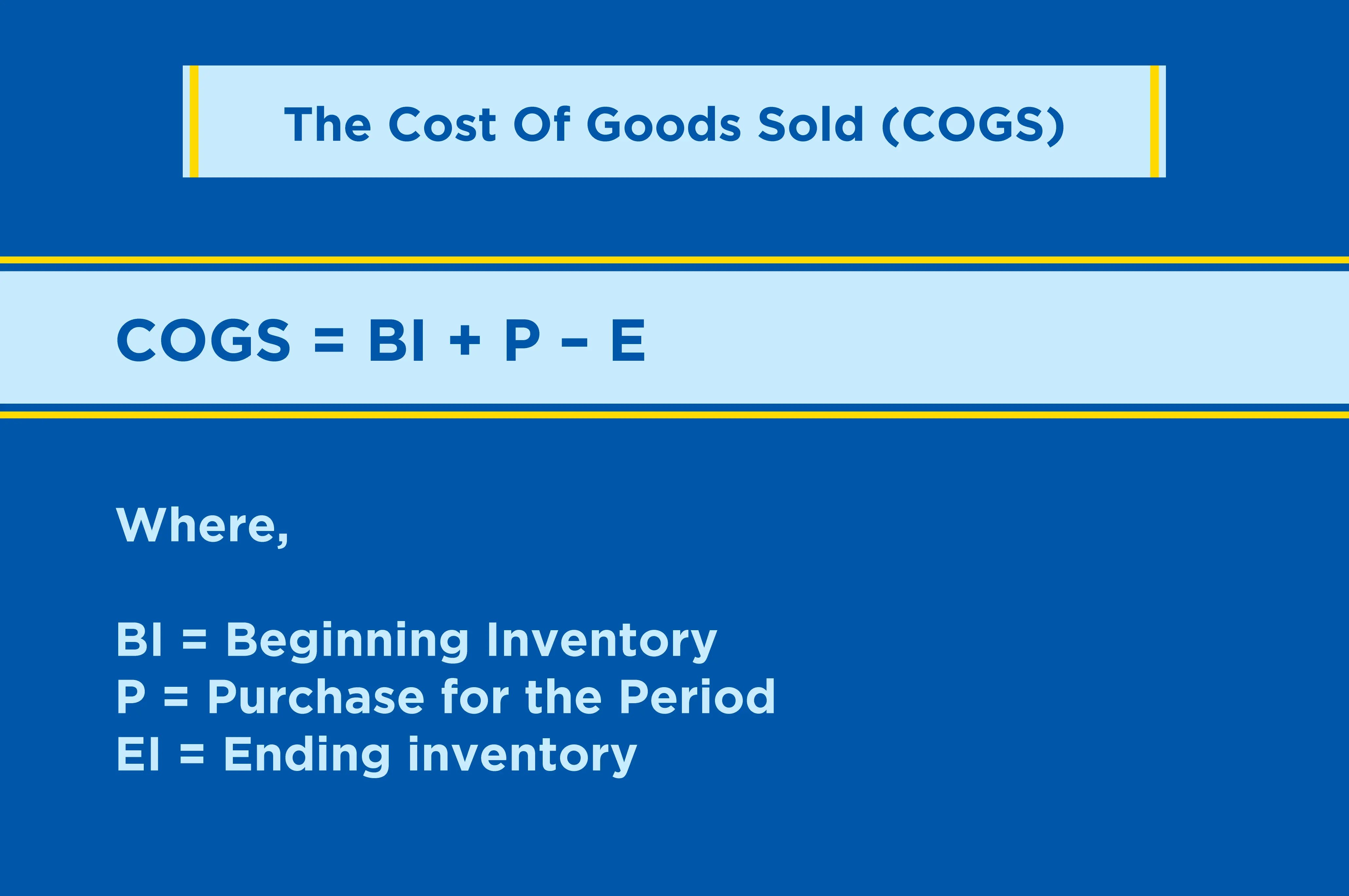
Examples of Perpetual Inventory System
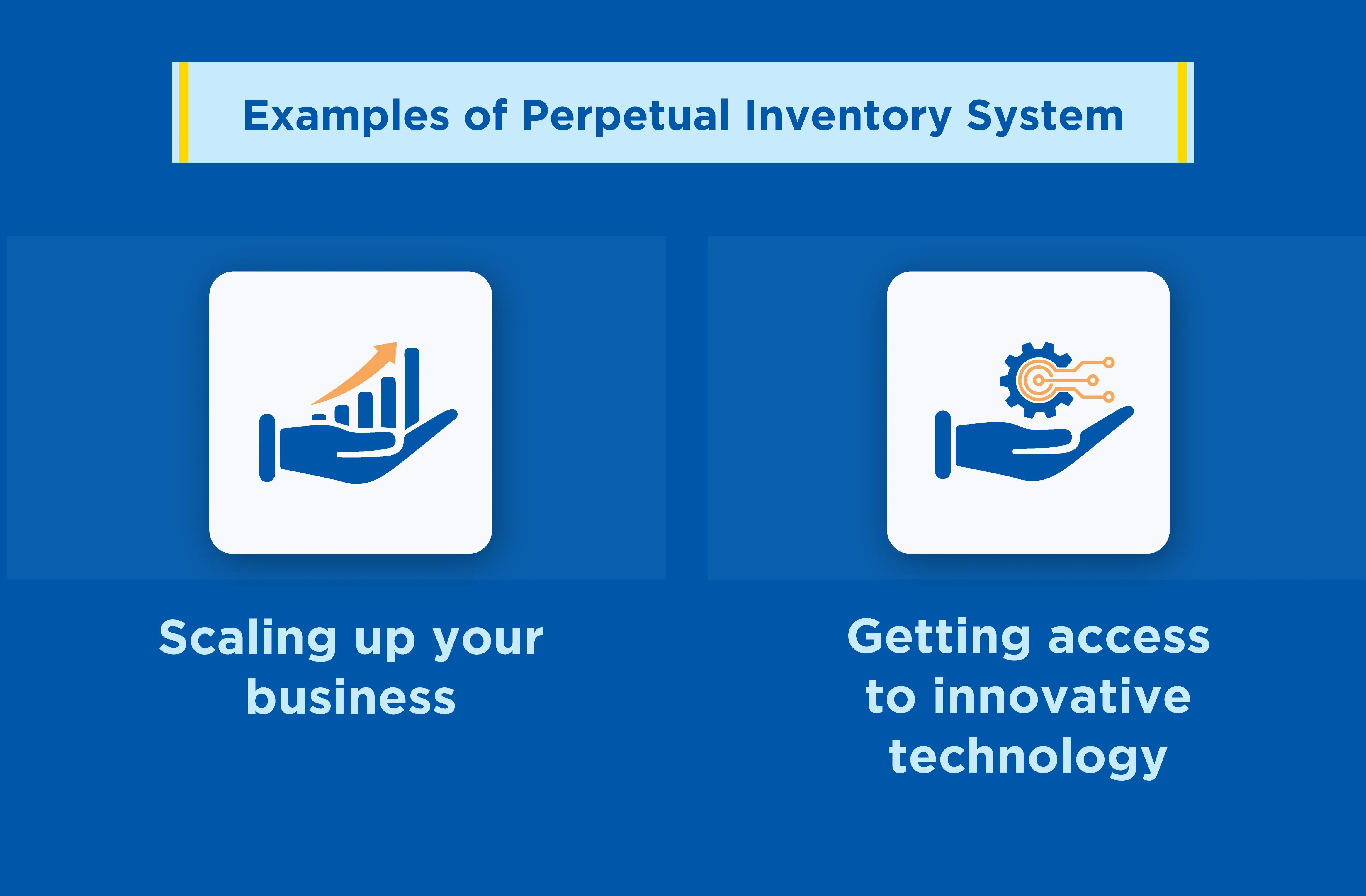
You might be wondering if implementing a perpetual inventory system in your own company is a good idea. Here are several scenarios in which a company would wish to go with perpetual inventory:
1. Scaling up your business
Because periodic inventory has become too physically burdensome for a fast-developing company, it may opt for a perpetual inventory system. For example, if you manage a bookstore and have recently increased your sales and built a second location, you may want to consider switching to a permanent inventory system to avoid the personnel costs involved with physical inventories. In this case, a perpetual inventory system would also make it easier to manage inventories across various locations.
2. Getting access to innovative technology
If new technology or hardware becomes available, it's also a good moment to start employing a perpetual inventory system. For example, if you own restaurants and have been using antiquated hardware for years and have recently purchased new register terminals, you may want to consider integrating a perpetual inventory system as well. Upgrades can be an excellent time to move to perpetual inventory if hardware limitations have stopped you from doing so previously.
Advantages of Perpetual Inventory
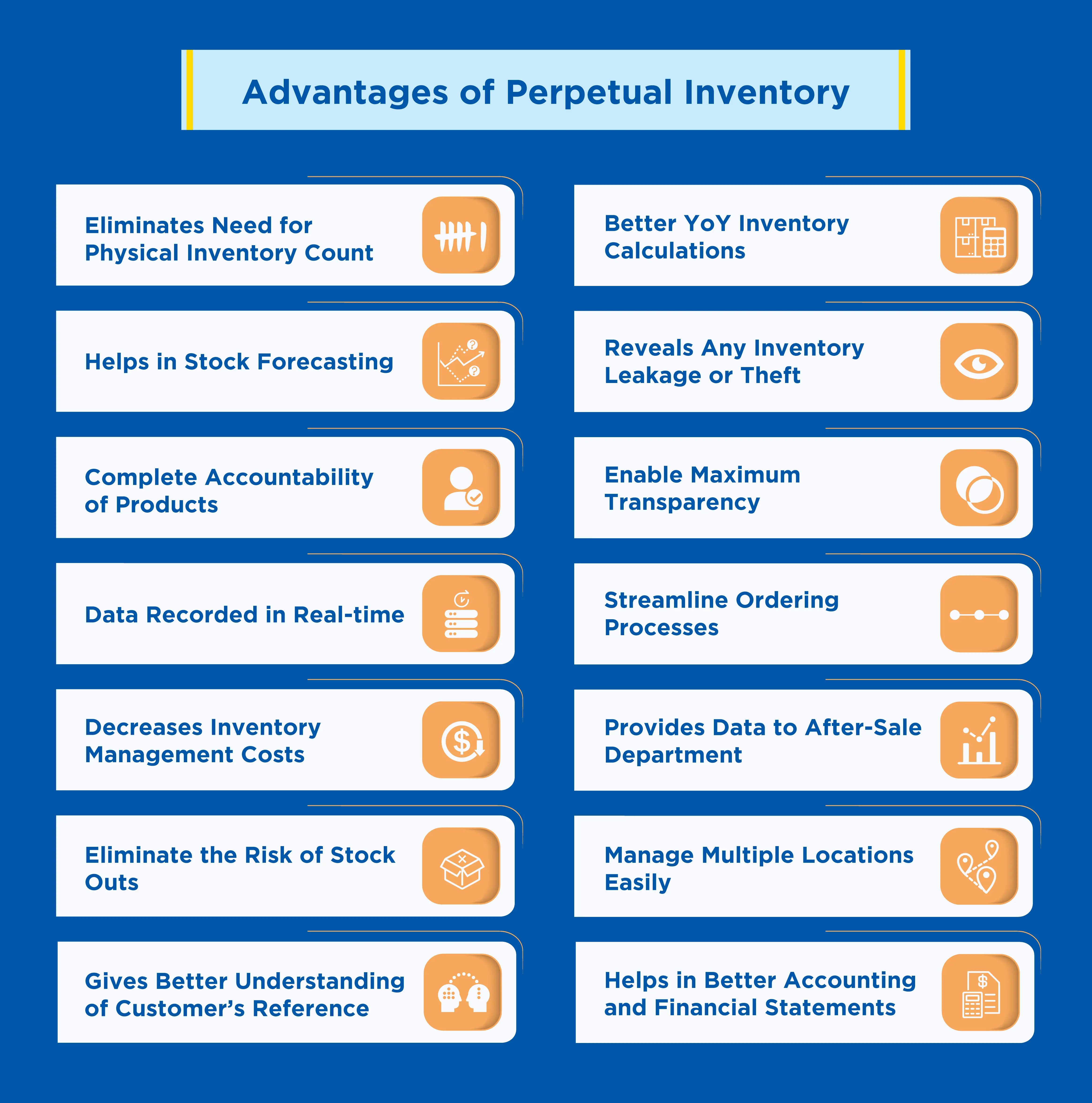
A perpetual inventory system can prove to be beneficial for eCommerce firms of all sizes. Not only does it aid in the real-time tracking of inventory data, but it also aids in the reduction of labour expenses and human mistakes. Let's take a look at why eCommerce companies choose a perpetual inventory system.
Eliminates Need for Physical Inventory Count
You don't need to bother about doing a physical inventory count every now and again because you know how many items you have on hand. The system gets updated in real-time. This saves a lot of resources, be it the time of your workers or the cost.
Helps in Stock Forecasting
Forecasting demand gets easier with a real-time inventory system. The data collected from the past inventory and sales can be used to predict future sales cycles. It will guarantee that you have the right amount of products at the right time of year, such as around the holidays.
You can see inventory levels, stock on hand, inventory cost, and things on order clearly. Perpetual inventory system can also guide you about adjusting the reorder levels for your best selling products as well as overstocked items.
Seasonality and trends, among other forecasting metrics, will help you store the most critical items while avoiding overstocking. This implies your company has less cash locked up in goods, which may be put to better use elsewhere.
Complete Accountability of Products
Inventory shrinkage costs a 1.82% loss for retailers all over the globe. You can avoid this by benefiting from higher accuracy if you use a perpetual inventory system. Customers will be less confused and disappointed as a result. With replenishment data, you can keep track of all of your products and make purchase orders with a single click.
You'll never miss an order if you keep track of your most popular items. In addition to that, all of your accounting records will have more precise inventory numbers.
Data Recorded in Real-time
Inventory modifications and movements are recorded in real-time by a perpetual system. This means you can bank on accurate inventory counts at all times. You'll have the most precise data possible with an advanced inventory management system. And it's all happening in real-time.
You can keep track of your warehouse's accounts receivable and sales orders being processed in your fulfillment centres. When returns are processed, the appropriate goods will be ready for resale almost immediately.
Decreases Inventory Management Costs
Inventory holding costs and inventory replenishments are controlled and decreased with real-time data. Perpetual inventory systems can reduce labour expenses by automating various procedures that would otherwise be done manually.
You may improve inventory control by using data-driven inventory demand planning. Of course, by performing lesser physical inventory accounting with real-time stock updates and tracking, your organisation may save money on labour expenditures.
Eliminate the Risk of Stock Outs
The perpetual method keeps stock-outs and overstocking at bay. Obviously, better inventory control will keep you informed about the status of your stock, allowing you to determine how much or little you require. Because you'll be notified when products need refilling, the perpetual inventory system will help you avoid overstocking and stock-outs.
Gives Better Understanding of Customer’s Reference
You can obtain a deeper knowledge of what consumers want with the perpetual system. You can analyse consumer behaviours and estimate demand for the following days since you can track credits or debits in inventory count in real-time.
Better YoY Inventory Calculations
With current statistics indicating a roughly 10% drop in retail sales YoY, it's no surprise that inventory levels would increase and fluctuate in the retail industry. The perpetual method helps comprehend what metrics to use to evaluate your inventory. Therefore it helps you figure out how much of an impact it has on your business and what the future holds with improved YoY inventory calculations.
Reveals Any Inventory Leakage or Theft
Inventory shrinkage occurs for a variety of causes, including damage, theft, and loss. It's the difference between what you think you have on hand and what you actually have. Because you always know the precise inventory level, the perpetual inventory method rapidly recognises any differences due to theft or shrinkage and avoids guesswork when it comes to determining replenishment levels.
Enable Maximum Transparency
Inventory centralization leads to complete transparency and improves accuracy. Businesses wishing to centralise their inventory and implement an omnichannel strategy can benefit greatly from a perpetual inventory system. Because each product's life cycle is tracked on its own ledger. You obtain exact data, which is more important than money in today's world.
Streamline Ordering Processes
Now that you can always have updated data regarding your stocks, the ordering process becomes smoother than ever. Streamlining makes your tasks even easier and more efficient. You can stay on top of the orders and avoid the churn rate that is caused by sold out items in your eCommerce store.
Provides Data to After-Sales Department
Your team can convey real-time data to salespeople. With more data flowing in on a regular basis, sales teams may use it to track and trace the packages, deliver accurate shipping information, and set client expectations, improving customer service levels.
Manage Multiple Locations Easily
Software that can combine inventory data from each site and sales channel act as a life-saver for businesses with many locations. Managers could easily overstock things if this is not done, resulting in excessive holding costs. Companies can locate products throughout the supply chain with the push of a button thanks to the perpetual inventory management systems.
Helps in Better Accounting and Financial Statements
Each time the company makes a sale or acquires new inventory, the perpetual system logs the changes into a sales revenue account in a perpetual inventory system. This method of recording sales guarantees that the accounting records accurately reflect the balances in the impacted accounts. The software also keeps track of the amount charged.
Disadvantages of Perpetual Inventory
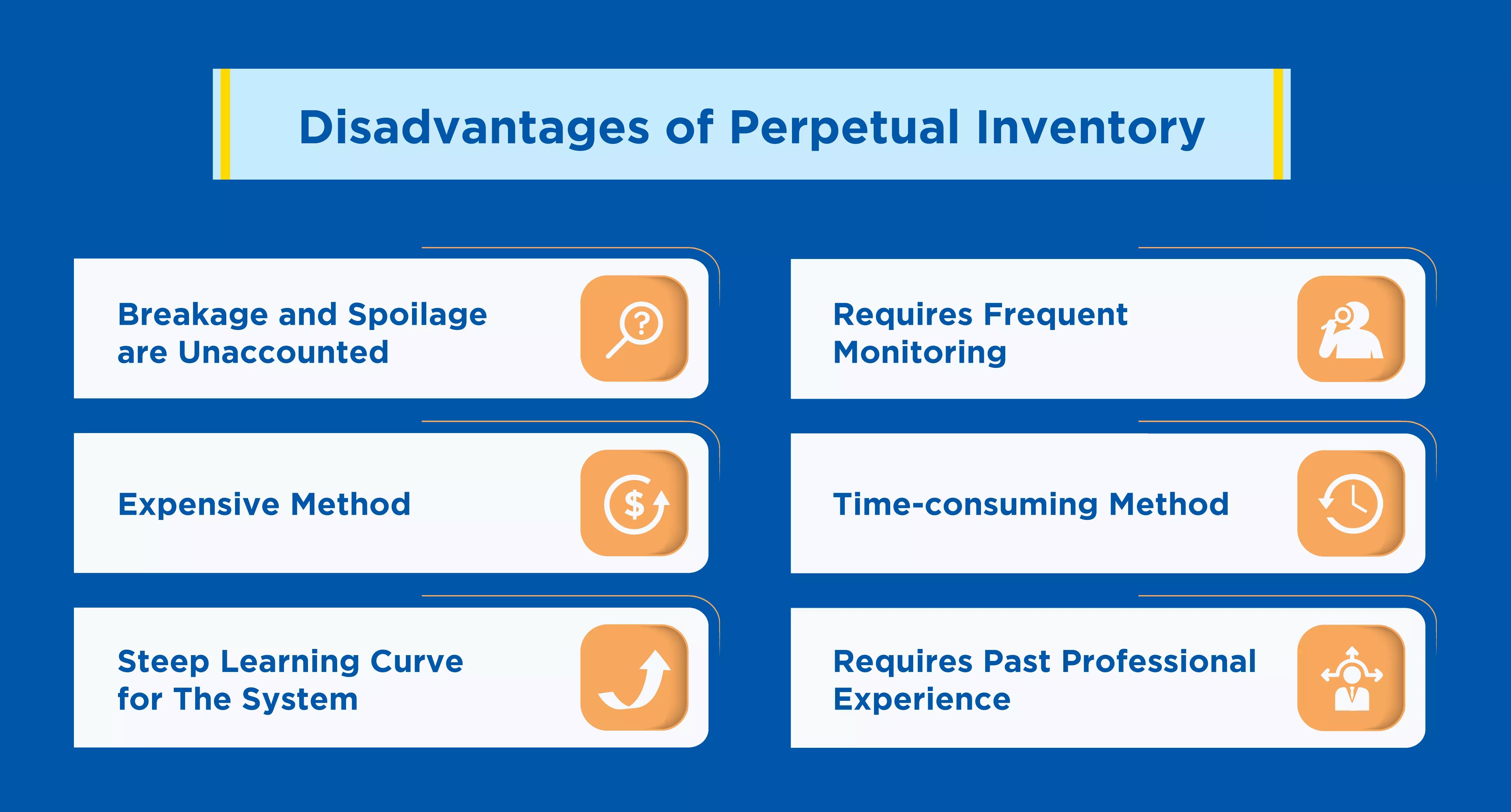
While the perpetual system undoubtedly has numerous advantages, there are a few cons that you should consider. It is necessary to be aware of the rare downside and prepare a way to avoid these disadvantages.
Breakage and Spoilage are Unaccounted
Continuous inventory tracking appears to be a smart method in general, but what if the inventory count is incorrectly updated? As the perpetual inventory system does not allow for regular physical inventory counting, there is a chance that inventory levels will differ from actual inventory in the warehouse.
This is because you cannot account for spoiled or damaged items. It can result in a discrepancy. You can learn about inventory write-off practices to avoid any confusion.
Expensive Method
Small firms may believe that implementing a permanent inventory system necessitates the purchase of inventory management software, IT infrastructure, and other specialist equipment. Employee training on how to operate them is another added cost that makes it expensive in the short term.
Steep Learning Curve for The System
The additional level of training necessary to implement a perpetual inventory system is another downside. Employees must be able to operate various scanning devices. Accounting professionals will need to be trained on how to use the inventory system.
Requires Frequent Monitoring
Another disadvantage is the additional training required to implement a perpetual inventory system. Employees must be able to use a variety of scanners. The inventory system will require training for accounting specialists.
Time-consuming Method
Adding barcodes and RFID tags to all the products can be a cumbersome process sometimes. Hence even though the process saves time by eliminating physical counting of each and every item, a few other tasks can demand a lot of time from your staff members.
Requires Past Professional Experience
When monitoring inventory levels, perpetual inventory systems might be deceiving. Employees are prone to making errors when entering amounts or scanning the incorrect inventory item. Merchandise may be stolen by shoplifters. So the staff needs to have some past experience to cope with the perpetual system.
How does a Perpetual Inventory Method Work?
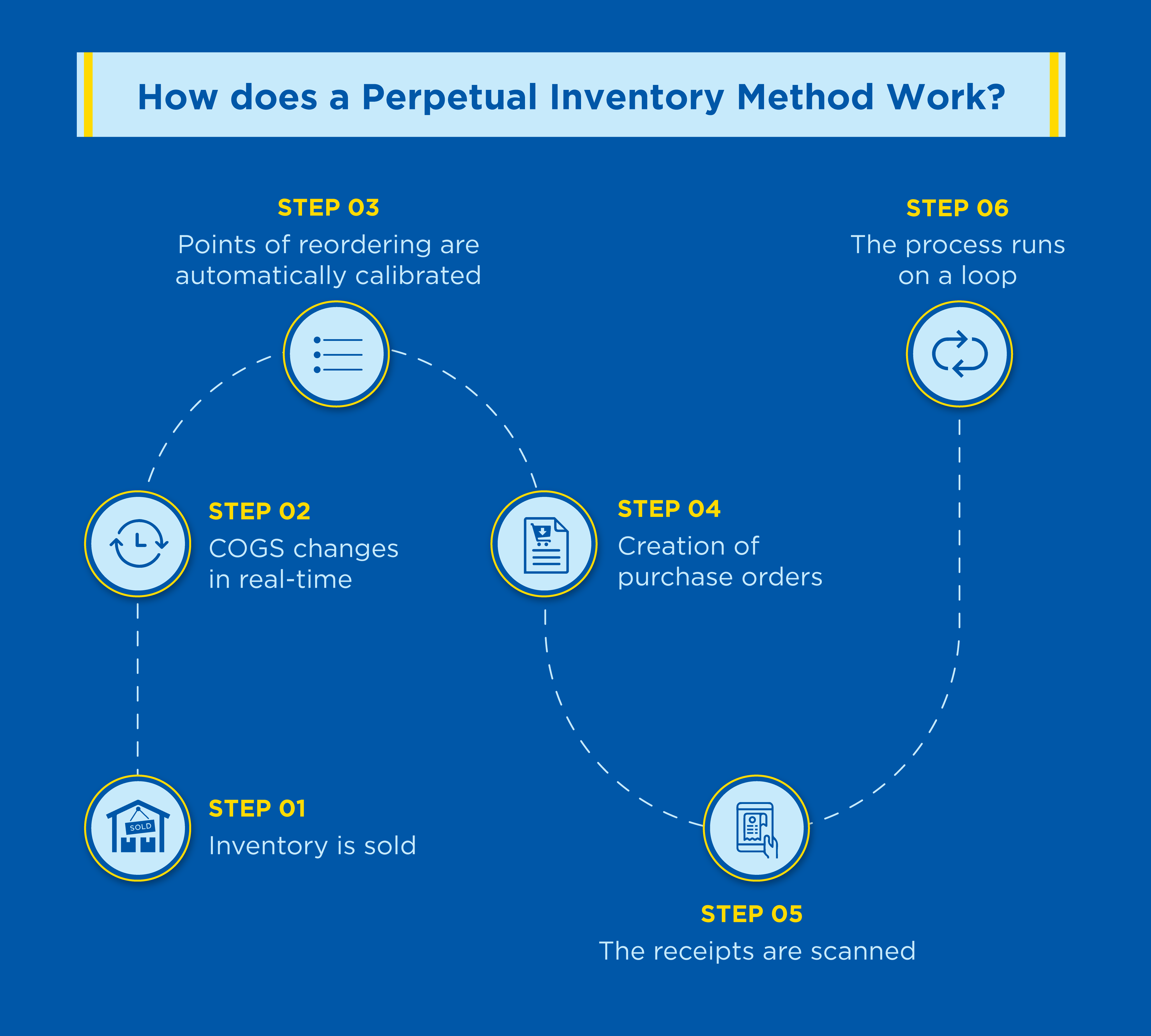
A perpetual inventory seems to be the ideal option for large and small businesses alike. Let's walk through the procedure to see how it all works.
1. Inventory is sold
When a customer purchases an item, it is scanned by a team member at the point-of-sale (POS). The POS system then debits the item from the inventory record and updates your account. In the case of an online transaction, this occurs automatically.
2. COGS changes in real-time
You can figure out your COGS using either the Last In, First Out (LIFO) or the First In, First Out (FIFO) accounting methods. The former calculates the cost of products using the most current purchase price. The latter calculates the cost of products based on the most recent purchase price. Your COGS is immediately updated whenever an item is sold or received.
3. Points of reordering are automatically calibrated
It only gets better with time as you start using your perpetual inventory system. As more historical data becomes available, the algorithm modifies ordering points to maximise stock levels.
4. Creation of purchase orders
A purchase order is automatically produced by the system when an item you carry exceeds the determined reorder point. The order is forwarded to your suppliers, ensuring that you and your staff do not run out of inventory.
5. The receipts are scanned
Your suppliers will ship to your warehouse or micro-fulfillment centre after they receive a purchase order. When your team receives the order, they scan the products, which are then automatically credited back to your inventory journal by your warehouse management system. The objects can now be sold, returned, moved, and used in other ways.
6. The process runs on a loop
The cycle then continues indefinitely. Your perpetual inventory system becomes better at improving the automation process as more data is collected.
Who Should Use Perpetual Inventory Method?
The perpetual inventory system is commonly used by large enterprises with many warehouses and enormous volumes of goods. SMBs wishing to expand quickly, on the other hand, can use this strategy to track inventory.
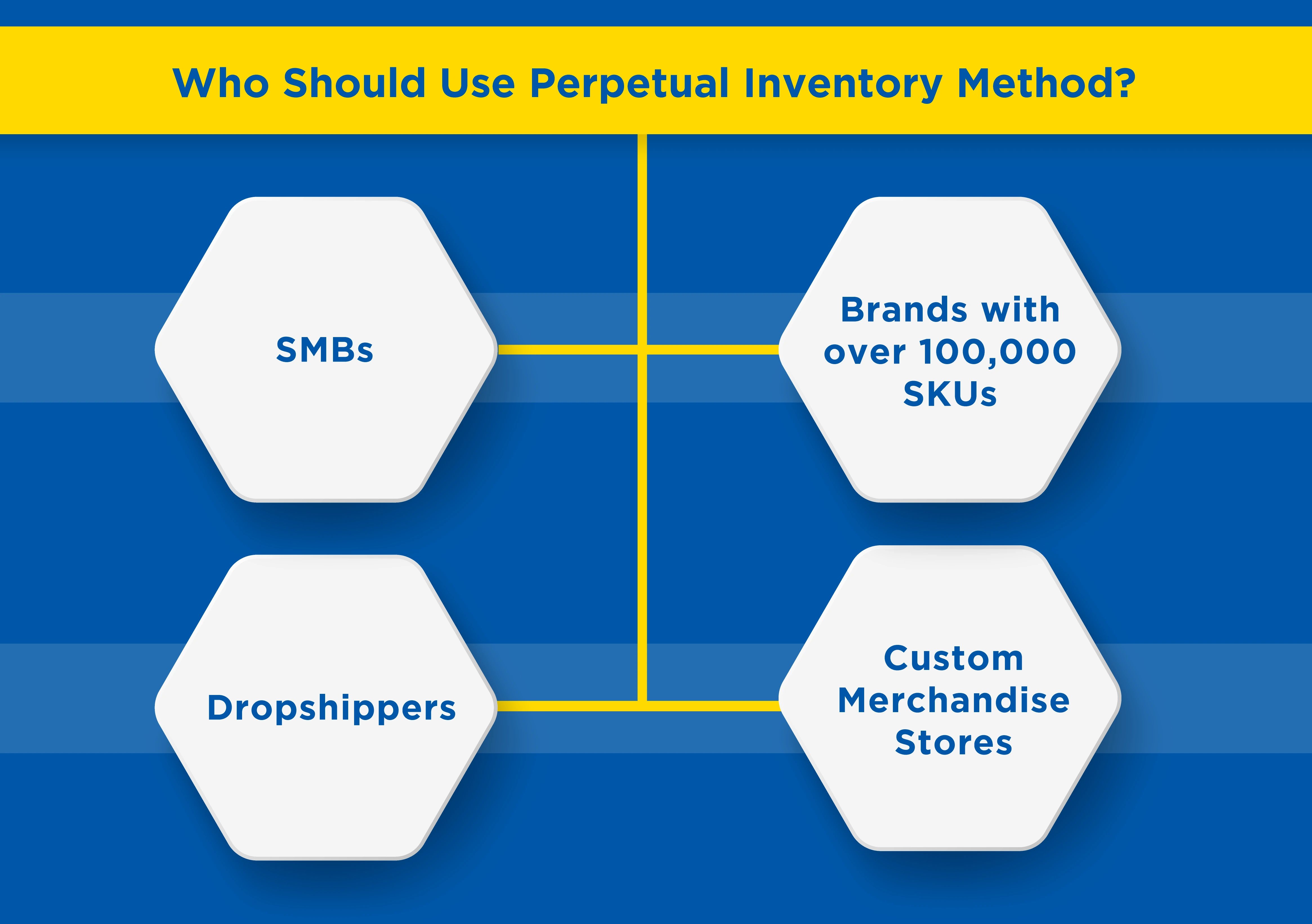
Enterprises that specialise in dropshipping, where producers ship straight to clients, or those that specialise in trade and distribution are examples of businesses that require perpetual inventory. The merchandise at these enterprises is constantly changing. There are also frequent returns and swaps. Constant updates or a permanent order fulfillment system are required to understand which stock is available at any given time.
For a large-scale enterprise with thousands or millions of Stock Keeping Units (SKUs), physically measuring inventories or performing cycle counts on a regular basis is nearly impossible. As a result, the most popular approach to inventory management is perpetual inventory tracking.
What is a Perpetual Inventory System?
A perpetual inventory system is a software that evaluates your inventory on a constant basis using computer data rather than a physical inventory. This process starts with a physical count as a baseline and then updates based on sales and shipments.
Continuous inventory management systems track inventory in real-time. It employs software to adhere to the laws and keep the system up to date, and it works flawlessly. Counting cross-sections frequently enough to account for the entire overtime is advocated. This may be considered everlasting, but it would have to be software-driven and obey the rules or do something different.
Perpetual inventory systems are more realistic because of the capacity of new cloud-based inventory management software to interact with all systems. It enables companies to streamline their financial and accounting processes. Because inventory is such an important asset to businesses, a perpetual inventory system allows accounting teams to provide more accurate tax and regulatory reports.
Best Practices for Perpetual Inventory System
Now that you are aware of the ins and outs of the perpetual inventory system, let’s have a look at some of the best practices to help you make the most of this method.
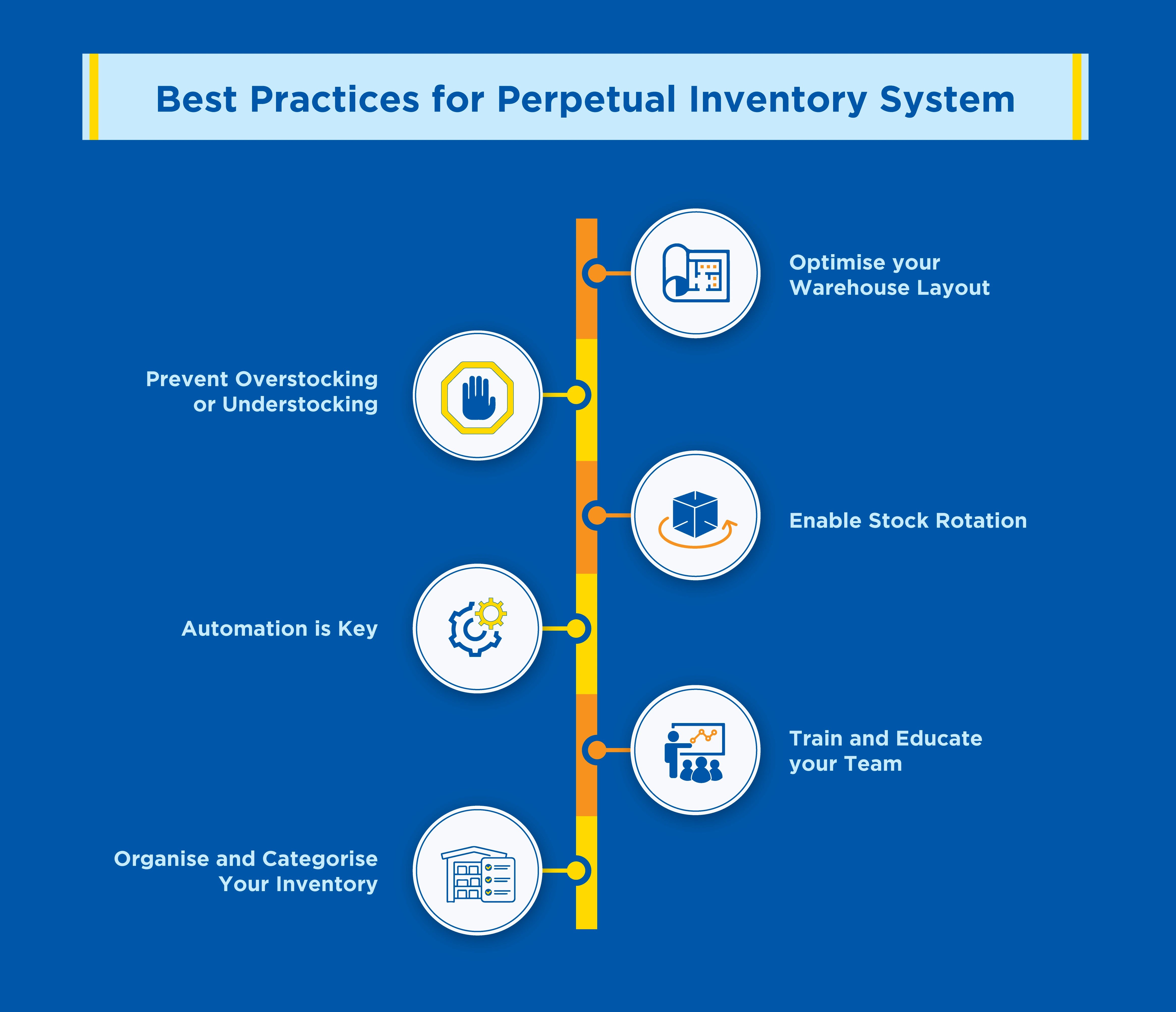
Optimise your Warehouse Layout
You can make better warehouse floor plan decisions with forecasting inventory management software. Keep your most popular things closer to your packing stations and less frequently purchased items further away. To protect against potential human mistakes, employ barcode scanners or an RFID tracking system as it provides 95% inventory accuracy.
Prevent Overstocking or Understocking
Slow-moving commodities cost you money and take up space in your warehouse that could be used for your revenue generators. In case your products run out, you risk losing a sale or worse, losing consumer loyalty.
Utilize your real-time inventory tracking to obtain accurate inventory data and attain inventory balance as quickly as feasible. With correct inventory data, you can fine-tune pricing, marketing, and other aspects of your business to help you get the greatest outcomes.
Enable Stock Rotation
Make sure the oldest products are the first to depart the warehouse for medium and slow-moving product lines. In addition to that, you might want to ensure that everyone knows that when it comes to packing orders, the oldest products come first.
This can be kept in check by keeping track of lot or serial numbers. Choosing the FIFO (first in, first out) costing approach over the LIFO (last in, last out) option goes hand in hand with this type of inventory management.
Automation is Key
When it comes to automation, make sure you utilise a high-quality platform to automate as much of the tedious and time-consuming job as possible. You can automate the following in addition to reducing stock-outs with automatic reorder points:
- Barcode scanning updates inventory levels
- Adjustments to the accounts
- FIFO valuation in real-time
- Order fulfillment and shipment control in one place
- Product bundles with inventory adjustments that are customised
Train and Educate your Team
Many of the routine activities of a perpetual inventory system can now be automated thanks to technological advancements. It saves time and money that may be put to better use in other areas of the company. However, the accuracy of its data is only as good as the humans who use it. As a result, it's critical to give adequate training and learning tools to all members of the relevant team.
In-depth online or in-person advice can be used to deliver training. The training sessions are customised to your company's demands and operations.
There are a variety of alternatives available, allowing each employee to complete the onboarding process at their own pace. Don't take any chances; make sure your everlasting inventory system is properly implemented.
Organise and Categorise Your Inventory
Make careful to pay attention to the early information you obtain as you begin to apply your new perpetual inventory system. Sort your products into three categories: best-sellers, average-sellers, and low-demand stock. You'll be able to invest your money more wisely and pinpoint the best reorder points this way. Your company will be able to fine-tune inventory levels and respond to changing patterns over time.
Wrapping Up
For fast-growing eCommerce enterprises, a perpetual inventory system seems to be the best option. A periodic inventory method is prone to discrepancies and has poor stock control. You can centralise inventory management, optimise stock levels, and much more with a perpetual inventory system. Built-in inventory management features, such as demand forecasting, order management, and data and analytics, are included in several eCommerce order fulfillment systems for advanced management.
Frequently Asked Questions (FAQs)
What is a perpetual inventory system?
A perpetual inventory system is a technique of inventory management that continuously updates your stock levels. Automatic updates are provided by inventory tracking throughout the supply chain. Sales, deliveries, transfers, trashing, and any other form of transaction are all monitored by the software.
The perpetual inventory systems make a lot of sense for e-commerce firms with a large volume of inventory movement and the modern business owner,
Inventory items are often scanned as they come and depart by your warehouse and sales teams. Manual recording, barcode scanning, or radio frequency identification are all options (RFID). The transactions are then turned into journal entries, which are used to update your inventory account.
What are the benefits of a perpetual inventory system?
You can experience the following advantages when implementing the perpetual inventory method:
- Stringent Inventory management: Businesses can keep a tight grip on their inventory by continuously monitoring it, knowing what comes in and what goes out.
- Reduces inventory and storage expenditures: You won't have to stock more than you need because you'll constantly be up to date on inventory count, expecting sales will be higher. Consider how much money and space you'll save if you only keep the amount of stuff you need. In other words, you'll save money on inventory carrying charges.
- Utilization of technology: For real-time inventory tracking, the perpetual inventory system makes use of the software. For proper inventory levels, products are scanned using barcode scanning.
- Works in conjunction with other inventory management techniques: By allowing you to have a proper grasp of inventory flow at any time, such as ABC analysis, FIFO (first in first out), LIFO (last in first out), EOQ, and so on.
What kind of businesses should use a perpetual inventory system?
A perpetual inventory system is a must for large scale businesses. Such advanced inventory management systems that ease the workflow keep the business running smoothly. They help keep a track of the products when the operations involve multiple stock-keeping units. Alongside, eCommerce stores and SMBs can also employ the benefits of real-time inventory management to expand their business.
How do you implement a perpetual inventory system?
When a transaction, such as a sale or a receipt, occurs, a perpetual inventory system updates the product database. Every product is given a tracking number, such as a barcode or an RFID code, that identifies it and tracks its amount, location, and other pertinent information.
Employees scan new products (along with their information) into the computer system when they arrive at a company. It would be difficult to manually track every transaction in a business without a computerised inventory system, especially in businesses that offer a large number of products.
This approach is reliant on effective inventory management. For instance, the system must ensure that staff scan in new goods as soon as possible. Physical counts to reconcile the database are uncommon, but important, because theft, loss, and breakage can skew the genuine inventory total over time.
Why is perpetual better than periodic?
A perpetual inventory system is more advanced than a periodic inventory system, and it is used more frequently. Inventory data is centralised and tracked in real-time by a perpetual inventory control system. All sections of the system have access to inventory data, which may be used to estimate sales patterns, compute reorder points, and locate items that are currently out of stock.
A physical count of products on hand at particular periods is used to determine COGS using inventory valuation methods such as FIFO, LIFO, and weighted averages in a periodic inventory system. A periodic inventory system determines current inventory counts and reports on them at the end of an accounting quarter or financial year.
